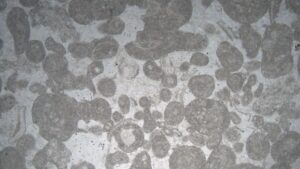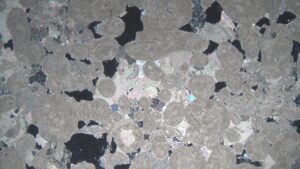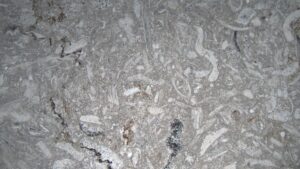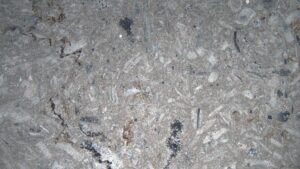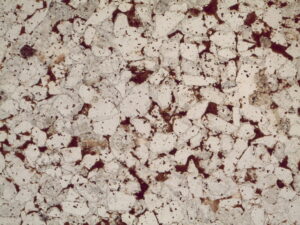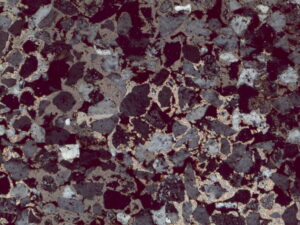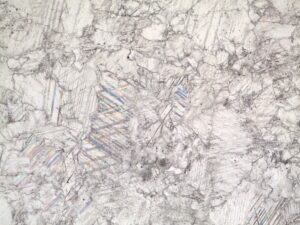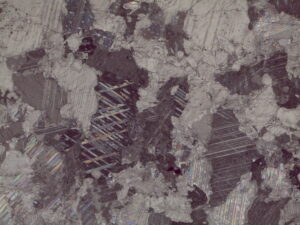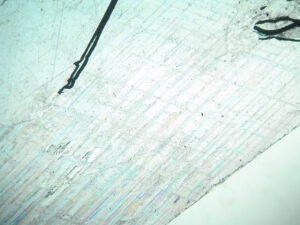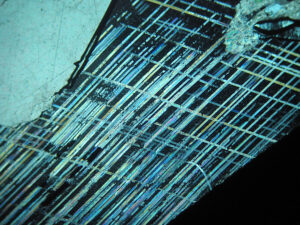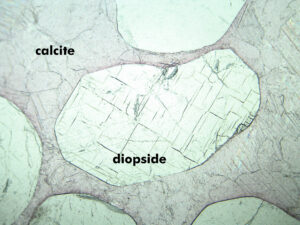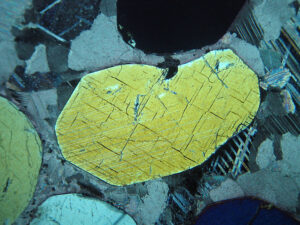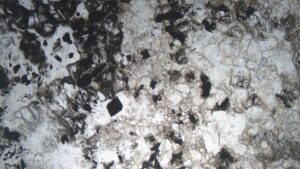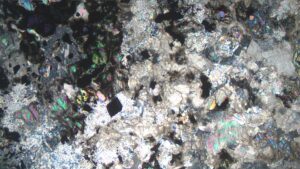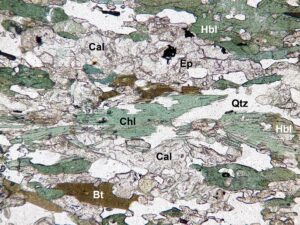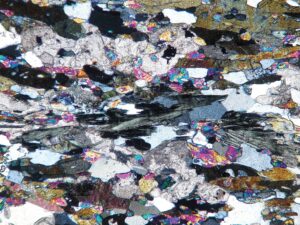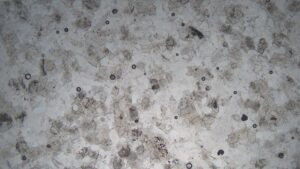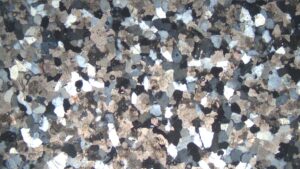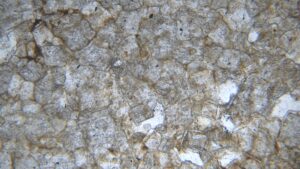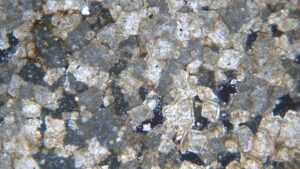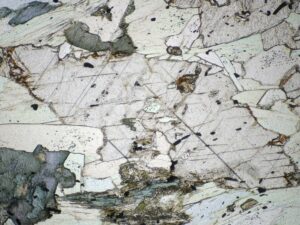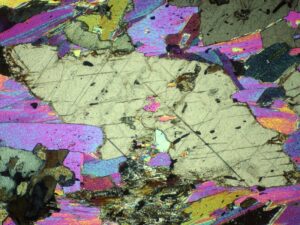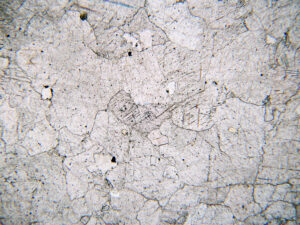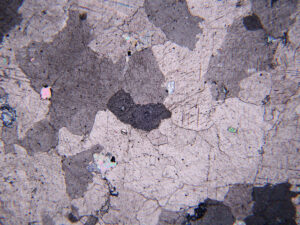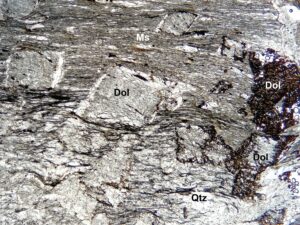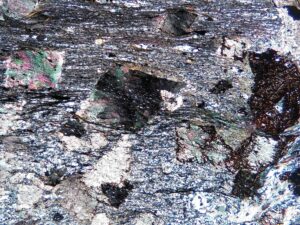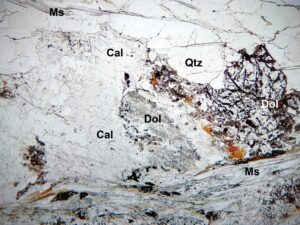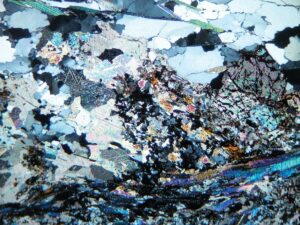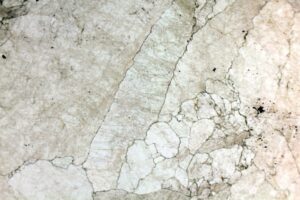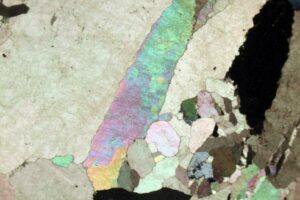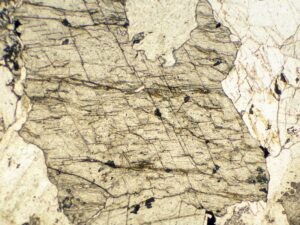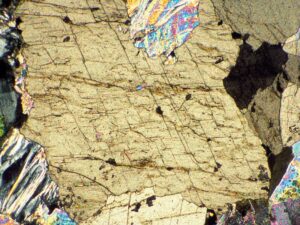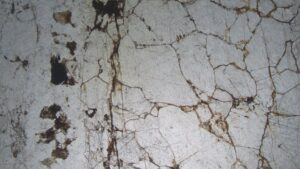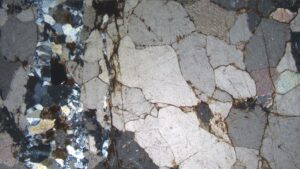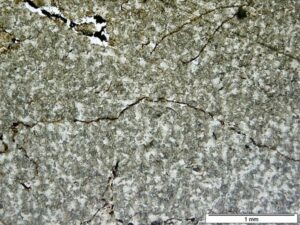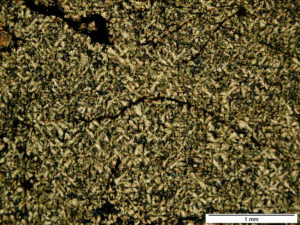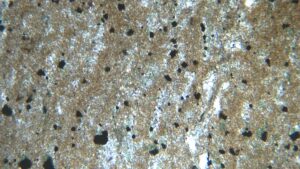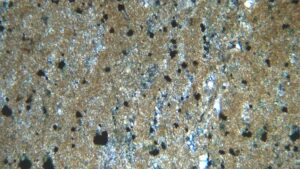9 Carbonates
9.1 Calcite
CaCO3
 Occurrence—Calcite is found in limestones, dolomites, marbles, marls and calc-silicate rocks, hydrothermal veins, and some rare igneous rocks (carbonatites). It is also a secondary or alteration mineral in many types of rocks.
Occurrence—Calcite is found in limestones, dolomites, marbles, marls and calc-silicate rocks, hydrothermal veins, and some rare igneous rocks (carbonatites). It is also a secondary or alteration mineral in many types of rocks.
Distinguishing Features—Calcite has characteristically low- to high-relief and is typically nearly colorless in thin section, but grains are sometimes cloudy. In plane-polarized light, calcite may show vague pastel hues or twinkling effects, especially along twin planes. Euhedral crystals are rare in thin sections. Fine- to coarse-grained anhedral patches or aggregates are typical; they may show relict organic structures if the carbonate has a biological origin.
Depending on orientation, calcite grains commonly exhibit variable relief with stage rotation. The mineral has perfect rhombohedral cleavage; if coarse enough, properly oriented grains show two intersecting cleavages.
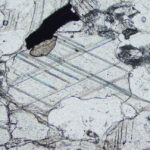
Calcite is almost always twinned and, unlike just about all minerals, polysynthetic twins often show as straight, sometimes colored bands in both PP and XP light.
Calcite has extreme birefringence; interference colors are very high-order pastels that may appear “pearl” white. Edges of grains (where thinner) may show identifiable 4th or 5th order colors.
Similar Minerals—Calcite is optically nearly identical to other rhombohedral carbonates including dolomite, magnesite, and siderite. Distinguishing calcite from dolomite can be challenging in thin sections. The best way is to use a red stain (called alizarin) that only colors calcite, giving it a light-pinkish hue.
Calcite has slightly lower relief than dolomite, but this is difficult to see, even when the two minerals are next to each other, because relief changes so much with grain orientation. Dolomite often forms euhedral rhombs, calcite does not. Calcite is commonly zoned. Dolomite is typically a bit more cloudy or beige than calcite due to discoloring inclusions. Alteration of dolomite (and other Mg- or Fe-bearing carbonates) can produce red alteration that does not occur with calcite.
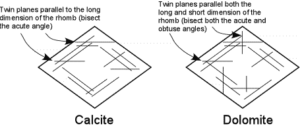
Calcite is more likely to display twins than dolomite. When present, dolomite twins are generally parallel to rhomb edges and both the short and long crystal diagonals. Calcite does not display twin lamellae parallel to the short crystal diagonal.
Siderite often has hematite stains. Aragonite, calcite’s orthorhombic polymorph, is biaxial and does not show rhombohedral cleavage.
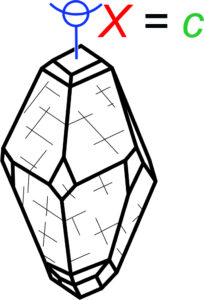
Optical Properties
■■ Rhombohedral; uniaxial (-)
■■ ω = 1.658, ε = 1.486
■■ δ = 0.172; interference colors are very-high order
■■ Extinction is symmetrical to cleavages
■■ Polysynthetic twinning is very common and usually visible, sometimes even in PP light
■■ Twin lamellae parallel to the long rhomb diagonal are often thin enough to show 1st-order colors
9.2 Dolomite
CaMg(CO3)2
 Occurrence—Dolomite is common in dolostones and in marbles. It also occurs in hydrothermal veins, as a secondary mineral, and as an alteration product in limestones.
Occurrence—Dolomite is common in dolostones and in marbles. It also occurs in hydrothermal veins, as a secondary mineral, and as an alteration product in limestones.
Distinguishing Features—Dolomite is very much like calcite. It is colorless to gray, occasionally brown, and has low- to high-relief. Crystals typically show polysynthetic twinning. However, unlike calcite, dolomite grains often have brownish alteration patches or borders due to iron oxidation. Also like calcite, relief may vary with stage rotation.
Dolomite crystals often form euhedral rhombs. Fine- to coarse-grained anhedral or subhedral aggregates are common too. Crystals may be bent or curved. Zoning may be visible due to variable Fe content in different parts of a grain.
Dolomite has perfect rhombohedral cleavage. If coarse enough, properly oriented grains show two intersecting cleavages.
Like calcite, dolomite has extreme birefringence; interference colors are very high-order pastels that may appear “pearl” white. Edges of grains (where thinner) may show lower (4th or 5th order) colors.
Similar Minerals—see the Similar Minerals section for calcite above.
Dolomite is very similar to magnesite (but magnesite does not twin). If dolomite is untwinned, distinguishing it from magnesite is difficult in thin section.
Siderite often has hematite stains, although dolomite can have reddish stains, too, if weathered.

Optical Properties
■■ Rhombohedral; uniaxial (-)
■■ ω = 1.679-1.698, ε = 1.502-1.513
■■ δ = 0.177-0.185; interference figures show many isochromes
■■ Extinction is symmetrical to cleavages; curved crystals show wavy extinction
■■ Polysynthetic twinning is very common and usually visible
■■ Twin lamellae, parallel to the long or short rhomb diagonals, are often thin enough to show 1st-order colors
| Fig 9.2.3 Dolomite in Schist
The central, large high-relief rhomb in this schist is dolomite (not calcite) as diagnosed by the directions of twinning. Colorless muscovite, gray-blue tourmaline, and tiny titanite crystals are also present. In the XP view, dolomite’s interference colors are too washed out to be seen. Muscovite shows up to high-2nd order colors. Tourmaline shows anomalous gray-green colors. Photos are from Oxford Earth Sciences Image Store. FOV = 2.5. |
Fig 9.2.4 Dolomite Marble
This marble comes from the Ruby Mountains, Montana. Almost all of the image is dolomite grains, which was verified by both an acid test and by staining. A few crystals of colorless talc and one pale brown phlogopite grain are also visible in PP. In XP, the colorful birefringence of the talc and phlogopite grains stands out. The very high birefringence of the dolomite appears as a pale pinkish-beige color. FOV = 5 mm |
| Fig 9.2.5 Dolomite in Schist
This calcium-rich schist from western Idaho contains large crystals of colorless high-relief dolomite with inclusion-choked cores and thin clean rims (PP). The right side of the image is the edge of the rock, and dolomite has been extensively altered along fractures to reddish iron oxides and/or oxyhydroxides (PP). The rest of this fine-grained rock is mostly moderate-relief colorless muscovite, low-relief colorless quartz, and fine grains of black graphite (PP). In XP, dolomite has pastel to pearly interference colors, quartz is characteristically gray to white, and muscovite has high 2nd- or 3rd-order colors. There are likely other minerals present, perhaps epidote and chlorite, but they are too fine-grained to make out at this magnification. FOV = 8 mm. |
Fig 9.2.6 Dolomite and Calcite in Schist
This low-grade calcic schist from western Idaho contains both dolomite and calcite. Both are colorless and display moderate relief, however, dolomite can be distinguished because it is susceptible to alteration. It is riddled with red and black alteration, unlike calcite that is pristine (PP). The rest of the rock consists of low-relief colorless quartz, and moderate-relief colorless muscovite (PP). In XP, dolomite and calcite show pastel to pearly interference colors, quartz is its typical gray to white, and muscovite shows 3rd-order colors. FOV = 3.5 mm. |
9.3 Magnesite
MgCO3
 Occurrence—Magnesite occurs in low- to medium-grade metamorphic rocks and in ultramafic rocks. It is most commonly an alteration product of mafic minerals. It also occurs in Mg-rich schists, in some rare chemical sediments, and as a secondary mineral in some limestones and dolomites.
Occurrence—Magnesite occurs in low- to medium-grade metamorphic rocks and in ultramafic rocks. It is most commonly an alteration product of mafic minerals. It also occurs in Mg-rich schists, in some rare chemical sediments, and as a secondary mineral in some limestones and dolomites.
Distinguishing Features—Magnesite is found in anhedral to subhedral crystal aggregates. Like other carbonates, it is colorless and has extreme birefringence. It shows variable relief with stage rotation but no twins.
Magnesite has perfect rhombohedral cleavage; properly oriented grains show two cleavages if they are large enough.
Similar Minerals—Magnesite may be difficult to distinguish from calcite and other rhombohedral carbonates. One key is that magnesite does not display twinning. Magnesite is similar to calcite in thin section but has a higher index of refraction.
See the Similar Minerals section for calcite and dolomite, above.
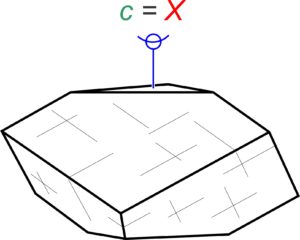
Optical Properties
■■ Rhombohedral; uniaxial (-)
■■ ω = 1.700, ε = 1.509
■■ δ = 0.191; interference colors are extremely high-order white/pearl
■■ Symmetrical extinction with respect to cleavages
9.4 Siderite
FeCO3
 Occurrence—Siderite occurs in hydrothermal veins, in limestones or dolomites, as a replacement mineral, and less commonly in metamorphic rocks.
Occurrence—Siderite occurs in hydrothermal veins, in limestones or dolomites, as a replacement mineral, and less commonly in metamorphic rocks.
Distinguishing Features—Siderite is typically in aggregates, fine- to coarse-grained; euhedral crystals are rare. It is colorless to gray, but often displays patchy yellow or brown iron staining. Like other carbonates, siderite shows variable relief with stage rotation.
Siderite has perfect rhombohedral cleavage; properly oriented sections show two cleavage traces if coarse enough. Coarse crystals may show polysynthetic twinning.
Siderite, like other rhombohedral carbonates, has extreme birefringence. Interference colors are very high-order but may be masked by the color of the mineral.
Similar Minerals—Siderite resembles other rhombohedral carbonates, but Fe staining helps distinguish it. Other carbonates normally have lower relief, but this is only a useful property if two carbonates are in the same thin section and at identical orientations (which is rare). Cassiterite appears somewhat like siderite but has lower birefringence and is optically (+). Titanite is biaxial.

Optical Properties
■■ Rhombohedral; uniaxial (-)
■■ ω = 1.851-1.875, ε = 1.612-1.633
■■ δ = 0.239-0.242; high-order pastels or pearl-white interference colors
■■ Symmetrical extinction with respect to cleavage
| Fig 9.4.1 Carbonatite
This is a siderite carbonatite (igneous rock) from Gunnison County, Colorado. The view here is mostly siderite. The brown hematite on grain boundaries is the key – without that, there would be no way to distinguish this carbonate from others. In the XP view, just a hint of siderite’s high-order interference colors is visible. A vertical vein, on the left side of the view, contains mostly small grains of quartz with a lesser amount of siderite grains. FOV = 3.5 mm. |
Fig 9.4.2 Siderite
No description available. Photos from open.agh.edu.pl. FOV = 3.5 mm. |
| Fig 9.4.3 Iron Formation
This is a sample of the Negaunee Iron Formatin from Michigan’s Upper Peninsula. The PP and XP views appear quite similar. The brown material in both views is siderite; opaque grains are magnetite. Clear grains (PP) are mostly quartz, but a small amount of calcite is present. It shows some pastel interference colors in the XP view. FOV = 1.5 mm. |
